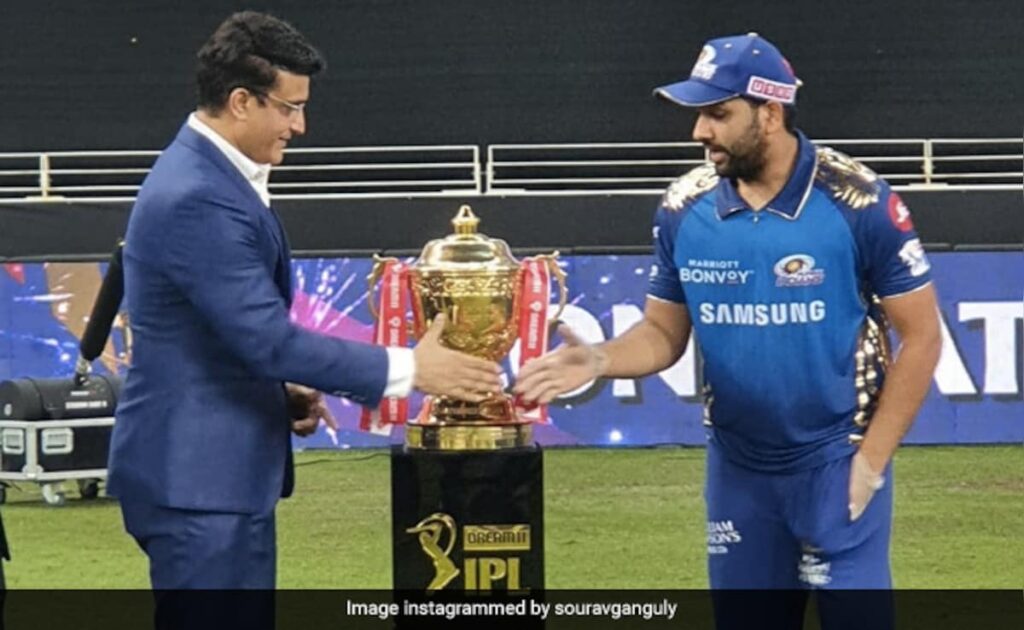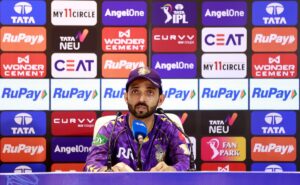
After Rohit Sharma's Sudden Test Retirement, Sourav Ganguly Says: "BCCI's Work Is To Support..."
Rohit Sharma Test Retirement: Sourav Ganguly Reflects on Hitman’s Legacy and BCCI’s Support Role
Former BCCI president Sourav Ganguly shares his thoughts on Rohit Sharma’s Test retirement and highlights the board’s supportive role in players’ careers.
In a development that has stirred the cricket world, Indian captain Rohit Sharma announced his retirement from Test cricket on Wednesday, concluding a distinguished red-ball career spanning 67 matches. Following this surprising announcement, former BCCI president and Indian cricket legend Sourav Ganguly weighed in on the Rohit Sharma Test retirement, emphasizing the cricket board’s supportive role during such transitions and reflecting on the ‘Hitman’s’ impressive legacy in the longest format of the game.
Table of Contents
- Ganguly’s Reaction: “BCCI’s Work Is To Support”
- The Retirement Announcement: How It Unfolded
- Rohit’s Test Career in Numbers: 4,301 Runs in 67 Matches
- The Test Journey: From Debut Century to Captaincy
- Home Dominance: The Foundation of Rohit’s Test Success
- Overseas Challenges: The Struggle in SENA Countries
- The England Breakthrough: Pataudi Trophy 2021-22
- Legacy and Impact: What Rohit Leaves Behind
- Future Outlook: Rohit’s Continued Role in Limited Overs
- Frequently Asked Questions
Ganguly’s Reaction: “BCCI’s Work Is To Support”
Responding to the news of Rohit Sharma Test retirement, former BCCI president Sourav Ganguly offered a measured perspective that emphasized both appreciation for Rohit’s contributions and the role of cricket administration during such transitions. “He is a great player for India, but someone has to leave the game. My best wishes to him,” Ganguly told ANI, acknowledging the inevitable reality of sporting careers.
Ganguly’s comments highlighted the multifaceted nature of Rohit’s cricket journey that will continue despite his Test exit. “He had a good career, he will play One Day for India and IPL… BCCI’s work is to support the player,” the former captain explained, emphasizing the board’s facilitative role rather than a directive one in players’ career decisions.
Reflecting on his own time at the helm of Indian cricket administration, Ganguly on Rohit retirement noted: “When I was part of BCCI, we thought he would be a great captain for India and so he was. We won World Cup, Champion’s trophy, Test Cricket under him.” This statement underscored the leadership dimension of Rohit’s career, which blossomed under Ganguly’s tenure as BCCI president.
Key Points from Ganguly’s Reaction
- Acknowledged Rohit as “a great player for India”
- Emphasized the natural progression of cricket careers
- Highlighted BCCI’s supporting role rather than directive influence
- Pointed to Rohit’s continued participation in ODIs and IPL
- Reflected on the decision to appoint Rohit as captain during his BCCI tenure
- Credited Rohit’s captaincy for multiple trophy victories
The Retirement Announcement: How It Unfolded
The 38-year-old batter took to Instagram on Wednesday to share the news of his Rohit Sharma Test retirement, crafting a heartfelt message that expressed gratitude to fans and reflected on his journey in the longest format of the game. The announcement came as a surprise to many cricket observers, particularly given Rohit’s recent success as Test captain and his relatively stable form in the format.
In his retirement post, Rohit reflected on his Test cricket journey with a sense of fulfillment and gratitude, acknowledging the support he received throughout his red-ball career. The timing of the announcement has sparked speculation about succession planning in Indian cricket, with questions about who will take over the Test captaincy now forming part of the ongoing cricket discourse.
The decision represents a significant moment in Indian cricket’s ongoing transition, with several senior players including Virat Kohli, Ravichandran Ashwin, and Ravindra Jadeja also approaching the latter stages of their Test careers. Rohit’s exit from the format marks the beginning of what could be a gradual changing of the guard in Indian Test cricket.
Rohit’s Test Career in Numbers: 4,301 Runs in 67 Matches
Over the span of his Test career from November 2013 to May 2025, Rohit Sharma Test career stats reflect a journey of persistence and eventual excellence. The numbers tell a story of a player who, despite a somewhat delayed start in the longest format, managed to create a substantial impact:
| Statistics | Figures | Context |
|---|---|---|
| Total Matches | 67 Tests | Career spanning 2013-2025 |
| Runs Scored | 4,301 runs | 16th highest for India |
| Batting Average | 40.57 | Solid by Test cricket standards |
| Centuries | 12 | Including a double century |
| Half-centuries | 18 | Demonstrated consistency |
| Highest Score | 212 | vs South Africa, 2019 |
| Home Average | 51.73 | Exceptional dominance |
| Away Average | 31.01 | Reflected challenges abroad |
Finishing as India’s 16th-highest run-getter in Test cricket, Rohit Sharma 4301 runs place him in distinguished company among Indian Test batters, despite playing fewer matches than many contemporaries due to his late establishment in the format.

Rohit Sharma amassed 4,301 runs in his Test career with 12 centuries and 18 half-centuries, culminating in a batting average of 40.57.
The Test Journey: From Debut Century to Captaincy
The Rohit Sharma Test legacy began with a memorable 177 against the West Indies at Eden Gardens, Kolkata in 2013, marking one of the most impressive Test debuts by an Indian batter. This innings immediately highlighted his potential in the longest format, though it would take time for Rohit to fully establish himself as a Test mainstay.
From 2013-18, Rohit played just 27 Tests, scoring 1,585 runs at an average of 39.63, with three centuries and 10 fifties in 47 innings. During this period, his position in the Test team remained somewhat fluid, as he struggled to find consistent opportunities and performance levels, particularly in challenging overseas conditions.
The real transformation in Rohit’s Test career came when he was promoted to open the batting in 2019, a move that revolutionized his approach to the longest format. This strategic shift brought out the best in his game, allowing him to leverage his natural attacking instincts while building a more disciplined foundation for longer innings.
Rohit’s Test Career Transformation
The evolution of Rohit Sharma’s Test career can be divided into distinct phases:
- Initial phase (2013-2018): Sporadic appearances, middle-order role, inconsistent performances
- Opening transformation (2019-2021): Promotion to opener, increased consistency, home dominance
- Captaincy era (2022-2025): Leadership role, increased responsibility, tactical evolution
- Overseas improvement: Gradual betterment in performance away from home, especially in England 2021
Home Dominance: The Foundation of Rohit’s Test Success
A defining characteristic of Rohit Sharma Test career stats was his exceptional performance in home conditions. In 34 Tests played in India, Rohit accumulated 2,535 runs at a remarkable average of 51.73, with 10 centuries and eight fifties across 55 innings. This home record forms the cornerstone of his Test legacy, showcasing his ability to dominate bowling attacks in familiar conditions.
His technique against spin bowling and his ability to convert starts into substantial scores made him particularly effective on Indian pitches. The confidence gained from these home performances gradually began to influence his approach to overseas challenges as his career progressed.
Rohit’s double century (212) against South Africa in 2019 at Ranchi remains the pinnacle of his home Test performances, demonstrating his ability to not just score centuries but convert them into match-defining innings. This innings epitomized his evolved approach to Test batting after taking on the opener’s role.
| Location | Matches | Runs | Average | 100s/50s | Highest Score |
|---|---|---|---|---|---|
| Home (India) | 34 | 2,535 | 51.73 | 10/8 | 212 |
| Away | 31 | 1,644 | 31.01 | 2/10 | 127 |
| Neutral | 2 | 122 | 30.50 | 0/0 | 43 |
| Total | 67 | 4,301 | 40.57 | 12/18 | 212 |
Overseas Challenges: The Struggle in SENA Countries
While home dominance characterized much of his Test career, Rohit overseas Test record presented a more complex narrative. In 31 Tests played away from home, Rohit scored 1,644 runs at an average of 31.01, with only two centuries and 10 fifties in 57 innings—statistics that reflect the challenges he faced in adapting his game to varied conditions.
The SENA countries (South Africa, England, New Zealand, and Australia)—often considered the benchmark for evaluating Indian batters—presented particular challenges for Rohit. His struggles in these conditions, especially early in his Test career, contributed to questions about his ability to succeed consistently at the highest level outside the subcontinent.
At neutral venues, his limited sample size of two Tests yielded 122 runs at an average of 30.50, with a best score of 43, further highlighting the gap between his home and away performances. This contrast between home dominance and overseas challenges remains a defining aspect of his Test career analysis.
Factors Behind Home vs. Away Performance Disparity
- Technical adaptability: Adjusting technique to moving conditions posed challenges
- Batting position: Initial middle-order role created inconsistent opportunities
- Confidence factor: Early overseas failures affected mental approach
- Strategic approach: Taking time to balance natural aggression with situational needs
- Later improvement: Notable progress in England (2021) showed potential for adaptation
The England Breakthrough: Pataudi Trophy 2021-22
The most significant highlight of Rohit Sharma SENA countries performance came during the 2021-22 Pataudi Trophy in England. This series marked a watershed moment in his overseas Test career, as he emerged as India’s leading run-getter, scoring 368 runs in four Tests at an impressive average of 52.57.
The tour included his memorable knock of 127 at The Oval, which represented his first and only century in SENA nations. This innings demonstrated a refined approach to his batting in challenging conditions, showing increased patience, tactical awareness, and technical adjustments that had been lacking in previous overseas tours.
This performance in England seemed to signal a potential turning point in Rohit’s ability to succeed consistently away from home. However, with his retirement coming relatively soon after this breakthrough series, cricket fans will be left wondering whether this represented the beginning of a new phase in his Test career that could have seen more consistent overseas success.
The Oval Century: Technical Adjustments That Worked
Rohit’s breakthrough 127 at The Oval showcased several key technical improvements:
- Playing closer to the body against the moving ball
- More disciplined approach outside off-stump
- Improved judgment of when to leave deliveries
- Patient build-up before unleashing aggressive strokes
- Better weight transfer on the front foot
Legacy and Impact: What Rohit Leaves Behind
As the cricket world processes the Rohit Sharma Test retirement, his legacy in the longest format emerges as multifaceted. While his statistical achievements place him among notable Indian Test batters, perhaps his greater contribution lies in his evolution as a player and his willingness to reinvent himself by taking on the challenging opener’s role later in his career.
Rohit’s captaincy, though relatively brief in Tests, demonstrated his tactical acumen and ability to lead by example. Under his leadership, India maintained their strong home record while continuing to compete fiercely in overseas conditions, further cementing their status as one of the most competitive Test teams globally.
His journey from a player once considered primarily a limited-overs specialist to a Test opener and captain represents an inspiring trajectory of persistence and adaptation. This aspect of his career may serve as a blueprint for future players seeking to expand their skills across formats despite early typecasting.
Future Outlook: Rohit’s Continued Role in Limited Overs
As Ganguly noted in his reaction to the Rohit Sharma Test retirement, “He will play One Day for India and IPL,” indicating that while one chapter closes, others continue. Rohit’s continued presence in limited-overs formats will allow him to focus his energies on areas where his impact has been most profound.
This strategic narrowing of focus may help extend his overall cricket career, potentially allowing him to build on his already substantial legacy in ODIs and T20Is. The decision aligns with a growing trend among modern cricketers to manage workloads by specializing in fewer formats as they progress through their careers.
For the BCCI support for Rohit will likely continue as he transitions to this more focused role, potentially benefiting from reduced physical demands while continuing to contribute his experience and leadership to Indian cricket in white-ball formats.
Frequently Asked Questions About Rohit Sharma’s Test Retirement
Why did Rohit Sharma retire from Test cricket?
While Rohit hasn’t elaborated extensively on his reasons, the decision likely stems from workload management at age 38, allowing him to focus on limited-overs formats where his impact has been most consistent. This strategic decision may help extend his overall cricket career.
What are Rohit Sharma’s key Test cricket achievements?
Rohit scored 4,301 runs in 67 Tests at an average of 40.57, with 12 centuries including a double hundred (212). He captained India in Tests with a positive record, and his transformation from middle-order batter to successful opener in 2019 represented a career-defining shift.
How did Rohit perform in home vs. away Tests?
Rohit averaged an impressive 51.73 in home Tests with 10 centuries, compared to 31.01 in away Tests with just 2 centuries. This significant disparity reflects his comfort in familiar conditions versus challenges faced abroad, particularly in SENA countries.
What was Rohit’s best overseas Test performance?
His finest overseas performance came during the 2021-22 Pataudi Trophy in England, where he scored 368 runs at an average of 52.57, including a century (127) at The Oval – his only hundred in SENA countries.
Who is likely to replace Rohit as Test captain?
While no official announcement has been made, potential candidates include Jasprit Bumrah (who has served as vice-captain), KL Rahul (who has captaincy experience), and younger options like Shubman Gill who represent the future of Indian cricket.
The Rohit Sharma Test retirement marks the conclusion of a remarkable red-ball journey that saw him overcome early challenges to establish himself as a respected Test batter and captain. As Ganguly’s comments remind us, the BCCI’s role remains supportive rather than directive in such transitions, respecting players’ decisions while helping navigate the evolving landscape of Indian cricket.
While statistics will preserve the numerical aspects of Rohit’s Test legacy, his impact extends beyond numbers to include his evolution as a player, his leadership during a transitional period, and his role in maintaining India’s competitive edge in the longest format. As he continues his cricket journey in limited-overs formats, his Test career stands as a testament to persistence, adaptation, and the pursuit of excellence.






